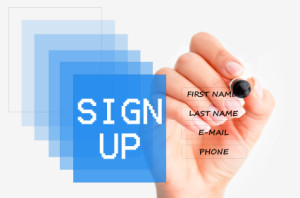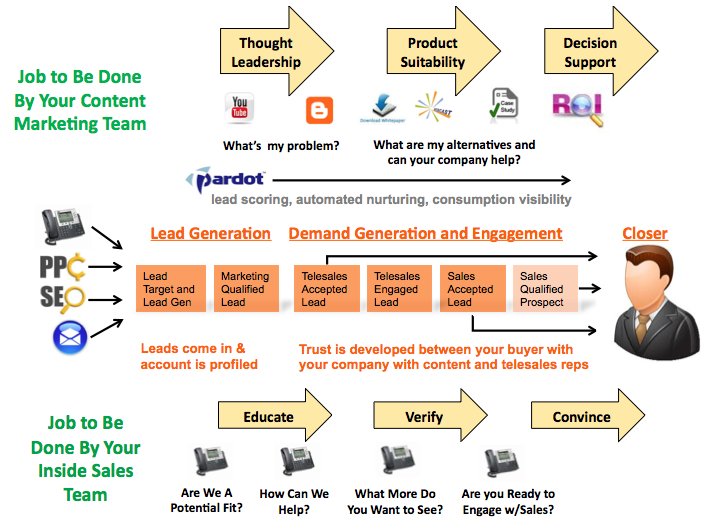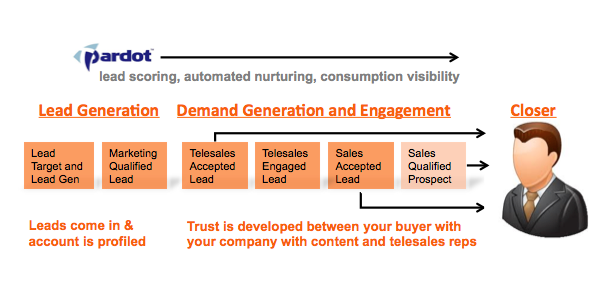by Glen Springer | Apr 1, 2013
 Marketers in nearly all industries are calling 2013 the ‘Year of the Customer’. This insight reflects the fact that in recent years, the sales cycle for B2B companies has shifted to focus much more on consumer demand. Developments in technologies and the globalization of business have created a world where marketers need to meet their prospects and customers on their own level, when and where the customer choses.
Marketers in nearly all industries are calling 2013 the ‘Year of the Customer’. This insight reflects the fact that in recent years, the sales cycle for B2B companies has shifted to focus much more on consumer demand. Developments in technologies and the globalization of business have created a world where marketers need to meet their prospects and customers on their own level, when and where the customer choses.
Customers now want to be treated like individuals with individual needs and desires. For marketers, this means providing individualized marketing content based on each prospect’s preferences and habits. Without marketing automation, this task can be daunting for B2B companies trying to reach hundreds or even thousands of prospects. When leveraged properly through a well-designed content marketing strategy based on buyer insights, a marketing automation solution can severely decrease the workload required for both B2B marketing and sales teams by reaching hundreds of prospects with a few clicks.
There are nearly endless pieces of the B2B sales and marketing process that can be automated with marketing automation. Here are 3 things that B2B marketers should always automate that will drive revenue while simultaneously decreasing the sales effort required to close:
- Customer/Prospect Data. In terms of new prospects, marketing automation is a great way to start a relationship while exerting very little effort. By creating and automating an email “Welcome Campaign,” you can offer basic information about the business problems you solve and request more information regarding prospects’ needs. You can also use marketing automation to maintain your existing customer relationships by asking them to update their information with any recent changes, which may present you with new opportunities to upsell.
- Reviews & Testimonials. Reviews of your product or service by your existing customers have tremendous value in the new, customer-centric sales cycle. Using marketing automation, you can solicit these reviews and then turn them into marketing content in the future. In addition to requesting reviews or testimonials of your product or service, you can ask reviews of the marketing content your prospects engage in as they move through the nurturing process. This will allow you to give your prospects more incentive to engage in your content (e.g. “This whitepaper was extremely insightful on industry changes and offered amazing tips for generating demand!”–John Smith, CEO) while also giving you feedback on how to improve your own marketing strategies.
- Events. Events are becoming more and more popular in B2B sales and marketing. Digital events like webinars and live demos are a great way to generate new leads and educate and nurture prospects. You can use marketing automation to send out many different types of messages related to an event, depending on a prospect’s behavior. After the initial invitation, you can automate different responses based on if the invitation was opened or if the prospect registered for the event. You can also automate “thank you for attending” emails containing new marketing content to prospects who actually attended your event while sending “sorry we missed you” emails offering recorded versions of the event to no-shows.
Marketing automation has the potential to take all (or at least most) of the guesswork out of the B2B sales cycle. Using marketing automation, you can gather customer insights at the same time you nurture prospects and close deals. Marketing automation puts the information you need to sell at your fingertips, as long as you know what to do with it.
If you would like to know more about how marketing automation helps B2B companies streamline their sales and marketing efforts into one easy-to-manage process, please feel free to contact us.
by gabriel_sales | Feb 13, 2013
 At Gabriel Sales, a B2B sales and marketing outsourcing company, we have experience accelerating the sales of both Fortune 1000 companies and small businesses. While the overall goals and basic sales strategy for each type of company is similar, they differ considerably in the amount of leads generated.
At Gabriel Sales, a B2B sales and marketing outsourcing company, we have experience accelerating the sales of both Fortune 1000 companies and small businesses. While the overall goals and basic sales strategy for each type of company is similar, they differ considerably in the amount of leads generated.
What we have found is that for small business B2B sales, companies have absolutely no chance of competing against their larger competitors if they do not implement the attitude that every lead matters. We believe it is imperative for small businesses to adopt the philosophy that you need to “work every lead.” Doing this will allows to increase the number of leads you put into your sales pipeline.
Our industry experience has shown us it is a pretty safe bet that your Fortune 1000 competitor employs an entire team exclusively to qualify leads. For this reason, we believe leveraging sales and marketing outsourcing team for this purpose may be necessary to keep up with the competition.
We also suggest this team, sometimes called a demand generation team, should directly report to the small business owner or the head of sales. This group should use a marketing automation platform and should be held responsible for the sales qualified leads put into the pipe. This will help ensure you reach your company’s hard sales goals in terms of revenue and your communication about progress happens in an ordered way.
Enacting the principle that every lead matters will make sure your small business is:
Professional—a lead that does not convert to a sales qualified lead may still turn into a referral, which can put you at an advantage in today’s ultra-connected world.
Responsive—there is evidence to show that ‘whoever gets there first, wins’ still applies in B2B sales.
Efficient—This structure will ensure that your company gets the best ROI on your program dollars, when measured in pipe to spend, or a close to spend type metrics.
Learning—every lead that does not qualify is an opportunity to learn something. The demand generation team will collect copious amounts of feedback in this process, which can be useful for improving your strategy in the future.
We have found that it is up to the small business owner or sales leader to be the champion of working every lead and to create the proper environment for this success. If you would like to know more about using an outsourced demand generation team for your small business B2B sales operations, feel free to contact us for a free benchmark and 30-minute needs analysis.

by gabriel_sales | Jan 16, 2013

Many B2B companies try so hard to generate more leads that they do not come up with a clear strategy for how to do so most efficiently and effectively. What these companies do not understand is that a successful campaign requires clearly defined goals and a well-articulated strategy.
This blog is meant to educate those with less experience in B2B sales and marketing about the fundamentals of lead generation. Specifically, we will address the difference between soft vs. hard lead generation for B2B sales and when each is most appropriate to use.
(If you would like information with a little more depth, please visit our knowledge center focused on B2B Demand Generation.)
The first step in creating a strategy for B2B lead generation is to formulate your overall goals. You should ask the following questions:
• Who are you trying to target?
• What is the number of leads you want to generate?
• What do you want to achieve in terms of sales?
• Are you willing to pay for a lead? How much?
• Where do you want your leads to be in the sales cycle?
The answers to these questions become essential in determining which lead generation technique will be most effective for your business. Depending on what your goals are, you will usually choose either a soft or a hard lead generation strategy. Hard techniques usually generate a higher quality lead, while soft strategies tend to produce large numbers.
The soft offer:
Using an incentive with an apparently low risk factor, soft strategies will give you huge numbers of leads. For example, if you offer free tickets to the World Series, you are likely to get a massive number of responses. The downside of the soft lead, however, is that most of these respondents are more excited about baseball than learning about your business. So, while the soft lead may give you the numbers you want, most leads generated in this way do not progress any further in the sales cycle.
However, in our experience as an outsourced sales and marketing company, we have found that offering an iPad or a gift card can be quite effective, especially in terms of generating a quick opt-in database. We have also seen that the soft lead generation strategy is most effective for businesses trying to target leads early in their sales cycle. This method will take much more time because of having to sift through large numbers and so should be used primarily when attempting to generate activity or jump-start your sales.
The hard offer:
In a hard lead generation strategy, you offer something that is relatively higher risk than free tickets or an iPad. When you make this type of offer, which may require some type of commitment from your prospect, the leads you generate are usually going to be much further along in their sales cycle. Some things you can use as hard offer incentives are free consultations, preliminary audits, invites to webinars, etc.
When engaging with these types of leads, you should be aware they have a much greater chance of becoming closed deals. We have found that a hard lead generation method is most effective for businesses that have little time to weed through huge numbers of leads and are therefore looking to talk to leads much closer to making a purchase.
If you are still having trouble deciding between soft vs. hard lead generation for B2B sales, a good place to start is deciding who you are trying to target. If your goal is to reach marketing teams, a soft offer may be the most appropriate. On the other hand, if you are looking to speak to buying executives, you may want to go with the hard offer. Once you decide the kind of lead you desire and determine what will be of value to them, you will be able to come up with a successful strategy for generating leads.
Gabriel Sales has over 12 years of experience as an outsourced B2B lead generation company. For more sales basics, please feel free to visit our Blogs on Sales and Content Basics.
by Glen Springer | Nov 23, 2012
 B2B marketing is changing dramatically and it’s going to take an even greater commitment by marketers to embrace and execute effective B2B marketing. Here are the top ten things I believe you need to commit to in 2013 to be part of the transformation B2B marketing is going through.
B2B marketing is changing dramatically and it’s going to take an even greater commitment by marketers to embrace and execute effective B2B marketing. Here are the top ten things I believe you need to commit to in 2013 to be part of the transformation B2B marketing is going through.
1) Commit to multimedia content marketing that truly educates your potential buyers. You want the content to be so strong that your prospects have full-heartedly believe that they are more intelligent around the topics presented in your content than they were before they consumed it. You want it to be diverse in type (video, eBooks, blog posts, webinars, etc.) because people learn differently (and search engines will reward you for the diversified content types).
2) Develop and adhere to a content publishing schedule. This is important for a few key reasons: 1) keeping all responsible parties on track regarding the content creation and publishing cycle 2) establishing a pattern with your audience so they confidently expect new education on a regular basis 3) the ability to batch produce, plan ahead and pre-schedule posting so that when the inevitable interruption deters you, you have a backup plan to get the content out on time anyway.
3) A greater commitment to search engine optimization. The foundations of SEO are in flux with the current state and changes in social media, content marketing, vertical search, continuous search algorithm changes, and more. We believe a full-time commitment to SEO is necessary for all B2B marketing campaign portfolios. It often produces the strongest leads and, when done correctly, has longer lasting passive lead generation benefits that other B2B marketing campaigns.
4) Develop a social media marketing plan. B2B Marketers need to develop and execute an actual social media plan with functions in place to measure the social media ROI. This plan should at least include the use of Facebook, Twitter, Google+, LinkedIn and other social forums that have an industry-related focus.
5) Dig deeper into your web/data analytics goldmine. First, make sure your analytics data is well organized in some type of central reporting area/dashboard. Secondly, establish regular review periods to assess current performance across your KPIs against historical benchmarks. Third, set up instant alerts that notify you of key opportunities or concerns.
6) Implement marketing automation software. 2012 was my maiden voyage into the world of b2b marketing automation software. On the consumer marketing side, I’ve used some tools that do some components of marketing automation, but nothing like what I’ve seen done in the past 6 months. Tools like Pardot, Marketo, Eloqua and a few others are changing the B2B marketing game big time, yet the adoption rate is is still low enough to where you can gain some true competitive advantages if you implement in a timely manner. There are more than a dozen recommended marketing automation strategies that I can think of. Look for an additional blog post on this, but in the mean time read this blog post on how marketing automation helps sales teams.
7) Optimize your landing pages. You are likely sending people to various landing pages through your different marketing channels. Additionally, there are organic landing pages that reveal themselves over time (using Google Analytics data). This is often your best chance to get someone engaged with your company – make it count. There are countless resources for “landing page optimization” some with opposing views, so my number one tip for landing page optimization is make sure you split test.
8) Improve your website’s user experience. Some examples of ways to do this include: 1) Improve your page load time. Page load time is a positive or negative user experience. A fast load time gets potential prospects to your content/message faster. Slow load time keeps your prospects waiting or worse, going elsewhere. People doing research want information fast. If your site doesn’t load swiftly, you are likely losing leads. 2) Consistent and easy to use navigation. You want users to be regular visitors to your site (either for purchases or continued trust building with your site as an authoritative hub). Good navigation helps your users get to where they need to go with ease. This also includes a good internal search engine. 3) Make it easy for them to take the most desired action on each respective page they are visiting, e.g. when offering a free whitepaper, make it abundantly clear what they need to provide and how exactly the whitepaper will be delivered.
9) Create a greater mobile experience for your websites. Whether its a responsive website re-design or delivering a mobile-based theme through device detection, more and more people are using mobile devices to consume content. Personally, I keep my laptop put away late at night and use my mobile devices to do research, solve business problems and to keep communication flowing (e.g. late night email, instant messaging, texting).
10) Get more involved in the lead nurturing and sales education process. Other experts I know in this space are predicting a much greater role to be played by marketers in strengthening demand generation, lead nurturing, and using targeted content marketing for sales education (moving away from just focusing on top funnel lead generation volume). B2B marketers should expect to be more deeply involved in the prospect buying cycle. This will require a more active participation with the sales team, product experts, and, most importantly, prospects themselves.
B2B marketing requires a new breed of marketers – people who are: knowledgeable/experienced in B2B selling, technically skilled, analytical, organized, productive, and business-savvy individuals who work well across teams to champion the creation of high performing, measurable, and predictable lead/demand generation and sales conversion systems.
Now, imagine the workload and personnel commitment required to make all that happen within a single company. First, you need at least one person to get up to speed on the changing tools, technologies, language and strategies required for the new rules of B2B marketing. Then, not only do you need that individual or team to learn all of this, you need them to be able to articulate it clearly across teams so that everyone understands and is on board with the changing rules and processes. Next, you need a diehard commitment to actually managing, implementing and optimizing all the different projects that come about by committing to the 10 issues above. Projects like website redesign, new software implementation, consistent content production, streamlining reporting/analysis, and more are huge undertakings.
At Gabriel Sales, we have:
- gone through the learning curves
- championed the transformation into various companies
- stayed abreast of B2B marketing best practices
- deployed the projects required to meet our B2B marketing recommendations
- continued to hone and optimize our own strategies as well as our clients
Working with an outsourced B2b marketing firm like Gabriel Sales will help you deploy these recommendations more quickly and cost-effectively compared to doing all of the work in-house. If you’d like to learn more about how we would help you, please request a complimentary review here.
by Glen Springer | Nov 11, 2012
 In Part 1 and Part 2 of this series, we discussed how buyers have changed the way they buy and why your approach to sales and marketing needs to change if you want more deals, to grow revenue, and to increase profit. We also discussed why your strategy needs to align sales and marketing around a pure focus on the customer “buying” cycle.
In Part 1 and Part 2 of this series, we discussed how buyers have changed the way they buy and why your approach to sales and marketing needs to change if you want more deals, to grow revenue, and to increase profit. We also discussed why your strategy needs to align sales and marketing around a pure focus on the customer “buying” cycle.
We pointed to the fact that companies who:
- Are ready for a longer sales cycle
- Educate their buyers first
- Create a shared scorecard to align sales and marketing
- Embrace emerging sales and marketing technologies
- And budget appropriately
have grown revenue 157% over the past 2 years while also reducing the total cost of sales.
In Part 3 of this series, we will discuss the core competencies and disciplines you’ll need to support to make this type of growth a reality.
What is B2B Lead Generation vs. B2B Demand Generation?
Before we get started it’s helpful to understand what we mean by b2b lead generation vs. b2b demand generation.
B2B Lead Generation – For Gabriel Sales, lead generation is about putting targets into your sales funnel at the very front end of the pipe. Adding a lead is simply finding a qualified person from a particular company that is interested in learning more about your product or service.
B2B Demand Generation – Is the process of moving that lead through a sales and marketing process to educate the buyer, bolster interest, and prepare them for speaking with the sales team.
Once you have a team in place that’s able to get the “B2B Demand Generation” process right, lead generation will become much easier.
1) Content Strategy: First, you’ll want to talk to your best sales reps to understand who your ideal targets are by decision maker type. Next you want to clone the sales process of these top sales reps to figure out what is the best thing to say to early-stage targets, what are the best early-stage offers, and what are the most frequent objections or questions in the early-stage sales cycle. You then need a content mapping tool and calendar to prioritize educational content based on the needs of your buyer and your sales team. We have developed a simple tool using Excel that is then shared in the cloud so it’s a live, agile marketing document. Someone will need to manage this document. It’s important that your content ultimately supports the sales script so the two work together to move deals into the pipe in tandem always focused on moving the buyer to the next step.
2) Content Production: It’s cliché but content is king. It drives traffic, provides value and converts visitors to subscribers and customers. Producing quality content is essential. Creating content is not the place to cut corners or try to shave costs. If done well and consistently, you’ll become recognized as a thought leader in your industry. This is a fantastic opportunity for you to differentiate yourself from your competition, because most companies don’t commit the time and resources to actually produce regular, quality content. Content then becomes quite literally an asset.
You’ll also want to leverage each piece of major content at least 3 times. So for example (and why we love webcasting) – if you commit to 1 to 2 webcasts per quarter you can typically turn that webcast into a white paper, create 3-5 shorter 1 to 2 minute video clips, and generate 7 to 8 blogs all from that initial piece of thought leadership. Take the content that you already know is engaging and working for your sales reps and product specialists in a live context and convert it into alternative, digitized pieces of content to distribute and share with your larger, not-yet engaged audience of early-stage buyers.
3) Content Management: Selecting a quality Content Management System (CMS) like WordPress is the first step in the content management process. You’ll also need to staff a resource to maintain your content schedule, add and edit content, and publish it into the right channels. Ideally, this same someone would also know how to contextually repurpose and publish your content. You also need to have the capability and capacity to create landing pages at will for specific verticals and decision makers to aggregate and focus your content for specific markets and buyer types. Gabriel Sales Digital Sales Base Camp™ was created to make this part of your content management seamless and efficient.
4) Email Management: Learning the rules, regulations and best practices of email marketing and management is not a core competency of many companies. A ‘Ready Fire Aim’ approach that doesn’t work when doing email marketing. Proper messaging, design (e.g. smart-phone compatibility), list segmentation, privacy/spam rules, auto-responder optimization, and more are all major factors in doing email marketing correctly. Many companies just blast their entire list and hope for the best, time and time again. Many others simply don’t do email marketing at all! The discipline is still required as a B2B lead generation tactic.
5) CRM Integration and List Acquisition: Making sure that all of your communication and analytic tools are synchronized with your CRM is an under-utilized practice, but one that can be the defining difference between converting a hot lead and losing a deal. Without conversions, b2b lead generation efforts mean nothing. You also need to make sure you are not spending money acquiring lists that don’t make sense or are redundant.
6) Landing Page Optimization: Use landing pages to deliver your critical content in an organized way that also promotes a compelling, ‘easy to take’, and singular call to action. This is an essential but usually undeveloped practice in many businesses’ web marketing/lead generation efforts.
7) Analytics and Database Management: The tools and methods of data discovery go into greater depths than ever before, but solid logic for how business decisions are made against all of this data are still lacking for many organizations. Companies spend incredible amounts of money for the tools but lose out on much of the ROI by not investing in the staff and education to actually use them to demonstrate meaningful insights. See Analytics Expert, Avinash Kaushik’s often-cited blog article on the 90/10 rule of web analytics success.
8) Graphic Design and Video Production: Having quality graphic design at the right times can set you apart from many competitors. Having the ability to take your existing presentations, customers and thought leaders and allowing them to get their best material circulating digitally will save your team 100s of hours annually educating customers.
9) Social Media and Reputation Management: Creating active engagement with your potential customer base in the major social media channels (Facebook, Twitter, LinkedIn and Google+) is an ideal to which your business should strive. Getting these profiles going is a step that many businesses have been reluctant to take and is necessary for mature b2b lead generation. Further, setting up tools to manage your company’s on-line reputation (e.g. creating alerts anytime your product, brand, management team is mentioned online) is becoming increasingly important to properly leverage positive feedback from brand champions and limit the influence of detractors out to destroy your business’ reputation.
10) Marketing Automation: This is the wave of the future for marketers and sales people, alike. Aside from investing in one of the top marketing automation tools (such as Pardot or Marketo), making an equal or greater investment in human resources to optimize your marketing automation is the next logical step. The added intelligence gained (e.g. lead scoring, real-time visitor analysis) and the powerful tools available (e.g. automated rules, logic-based drip campaigns, page actions) will transform your lead generation and sales prospect prioritization beyond anything you’ve done before. If you are unfamiliar with marketing automation, now is the time to educate and get on board. GS is an authorized Pardot Agency Partner (among several other technologies) so we have a bias for Pardot and we can offer unparalleled ability in implementing and optimizing these tools to quickly accelerate marketing results for any business. If you have never checked out a marketing automation demo don’t hesitate and take the time for a 5 Minute Overview of Marketing Automation right now!
11) Phone Resources: Effective lead generation and lead nurturing still requires people to pick up the phone. You need to strongly consider attaching reps to your marketing team and not your sales team. In terms of demand generation there is a difference between ‘educating’ buyers vs. ‘selling’ buyers. Getting this part wrong can destroy your entire investment up to this point. Getting this part right will give you a huge leg up on your competition because:
- 70% of leads are passed to Sales Reps before they are ready to engage (Marketing Sherpa -2012)
- 80% of mishandled leads will buy from a competitor (Forrester -2011)
And if you have the other pieces we’ve described above in place, like quality content production, marketing automation and social media management, your phone reps will have an easier time with b2b lead generation and creating engaged, meaningful discussion with prospects and the end results will be far more beneficial to your conversion goals.
Summary
The seismic shift we are seeing right now essentially means that marketing now needs to own the prospect much earlier in buying process and take them much deeper. The goal is to connect the buyer with the sales rep when the buyer is ready to buy. This approach leads to faster transactions and maximizes the sales reps time. The line between sales and marketing as it applies to demand generation is getting blurred and this trend is not going to abate any time soon. You need to softly press for next steps with both your reps and your content. This is why its key to pull in a marketing automation platform will accelerate your ability to pull it all together to score a prioritize leads. In Part 4, we’ll discuss in more detail how marketing automation can help your sales and demand generation process.
The job and landscape is getting more complex. So who is going to actually do all this work? How do you find marketers that understand sales and sales staff that understand marketing? This is where considering to outsource to a b2b lead generation company with expertise in outsourced sales and marketing may be able to help. So feel free to request a free consultation if you are curious how we can help.
Part 1 – Increasing Your B2B Sales Volume and Revenue – What’s Changed?
Part 2 – What Does Your B2B Sales and Marketing Culture Need to Look Like?
Part 3 – What Core Competencies do I Need From My Marketing and Lead Generation Team?
Part 4 – How Can Marketing Automation Improve My B2B Sales Performance?
Part 5 – Why is Content Marketing is Now Required for Quality B2B Lead Generation?
by Glen Springer | Sep 4, 2012
This blog is part of a two part series that discusses two marketing automation implementation best practices to accelerate your demand generation engine implementation using Sales Lead Definitions. These marketing automation implementation best practices allow marketers we work with to increase their initial lead volume from our initial Gabriel Sales Ramp™ Campaign (to keep the sales team happy) while we also help to build your engine.
As background – as Gabriel Sales works with our clients building a repeatable telesales process and demand generation engine, we often discover that your company has great metrics and processes to move deals from “Sales Qualified Opportunity” to “Close” but limited visibility into the Early Stage Pipe metrics. Just like late stage pipe velocity, using Sales Lead Definitions to define the discrete stages of your early stage pipe is critical to success of any integrated content marketing and sales effort to put more sales qualified leads into the pipe.
The purpose of this blog is to introduce a marketing automation implementation best practice using Sales Lead Definitions to help accelerate agreement on how the early stage pipe can be scored so your sales team:
- Can quickly help marketing create the lead definitions and get back to selling
- Has the flexibility to successfully take early stage leads from the pipe in the short term to take advantage of the initial lead volume
- And as the engine reaches maturity, the sales team reaps the benefit of more sales qualified leads in the mid and long term
Starting with the End in Mind with your Marketing Automation Implementation
Building a Demand Generation engine does not happen overnight but once created it pays huge dividends. The top three short term benefits are:
- Turn buyers ready to buy into Sales Qualified Leads faster to increase your sales pipeline’s velocity
- Maximize your lead generation budget by effectively nurturing leads not ready to buy so when they are ready to buy they buy from you, (which will eventually increase the size of your sales qualified pipeline)
- Reduce the cost of time spent by your senior sales reps and product specialists educating and selling to buyers that are not ready to engage with sales yet (or buyers who are just kicking the tires and never plan on buying) so your top resources spend their time focused on “closest to the dollar” activities.
Once the engine is built the end goal is to take your increased revenue and the bottom line savings your demand generation engine is producing to:
- Put more even more leads into the pipe
To build an engine requires a telesales team and marketing team aligned with a singular focus of putting more sales qualified leads into the hands of your closers. Below is how this alignment works.

A Framework for Agreement on the Lead Stages is a Critical Marketing Automation Best Practice
Most clients we work with are generally great at defining what a “Lead” is and what a “Sale Qualified Lead” is. If a company has an active inside sales team in place already they may have some of the other sales lead definitions in place as well.
As part of our initial consulting work we work with the sales team to distill specific probing and open ended questions that can be used in the early stage sales process to define where the buyer is in their sales process. This is then used by both marketing and the inside team to support the sales team.
Ultimately the key driver to the organization is going to be how many deals actually close. What a combined telesales and marketing team can impact is how many “Sales Qualified Leads” get in the hands of the “Closer”.
There is no one right and wrong way to set the criteria below. What we are sharing is a starting point so your executives and your closers can evaluate the early stage pipe and make better decisions about what actions to take. For sales specifically it is meant to communicate where the buyer is in their buying cycle, if and when sales should engage and how sales should approach engaging your buyer (where is the buyer in their buying cycle). The criteria below allows your marketing automation to do its job and allows your inside team to move deals through the pipe more effectively. When properly executed you will:
- Save your closers and product specialist’s bandwidth.
- Allow your sales team to “cherry pick” leads from the pipe earlier if they see an opportunity they would like to pursue.
- Clearly communicates to your sales team where the buyer is in their buying cycle so they know how to best approach that buyer.
 Lead Target – The decision makers and companies you are targeting. Ideally you are targeting an ideal customer profile.
Lead Target – The decision makers and companies you are targeting. Ideally you are targeting an ideal customer profile.
Marketing Qualified Lead – Any lead that has expressed mild interest or raised their hand and opted into receiving content from your company. The source of the lead does not matter.
Telesales Accepted Lead – A lead where the company is the right fit (right account profile) and the buyer you are speaking with has the interest in learning more. May have the ability to influence or may have the ability to get you in front of the influencer or decision maker.
Telesales Engaged Lead – (a sub set of Telesales Accepted Lead). There is an agreed next step. Could be in a week, month or could be in a quarter. In some cases it could be at a specific point in time for next year’s budget cycle. Typically the buyer has been asked if they are ready to talk to sales and has declined “not yet but stay in touch”.
Sales Accepted Lead – You know the lead has the ability to influence or champion. Your product can solve a problem the buyer has articulated. May be willing to schedule an appointment. May require someone more senior to move forward.
Sales Qualified Lead – Meets one or more of the following criteria. Decision maker is involved. Path to budget or live budget is in play. A champion has expressed interest in moving the deal forward with you. Specific pain or need has been articulated by the buyer.
We generally find that reaching the initial agreement is simple to reach as part of our initial interview process. Once the questions and criteria are in place we are able to work with our client to keep lead volume up as we work with our clients to build the engine. For more marketing automation implementation best practices details check out our next best practice blog – How to Keep Volume Up as You Build Your Engine.
.
 Marketers in nearly all industries are calling 2013 the ‘Year of the Customer’. This insight reflects the fact that in recent years, the sales cycle for B2B companies has shifted to focus much more on consumer demand. Developments in technologies and the globalization of business have created a world where marketers need to meet their prospects and customers on their own level, when and where the customer choses.
Marketers in nearly all industries are calling 2013 the ‘Year of the Customer’. This insight reflects the fact that in recent years, the sales cycle for B2B companies has shifted to focus much more on consumer demand. Developments in technologies and the globalization of business have created a world where marketers need to meet their prospects and customers on their own level, when and where the customer choses.
 At Gabriel Sales, a B2B sales and marketing outsourcing company, we have experience accelerating the sales of both Fortune 1000 companies and small businesses. While the overall goals and basic sales strategy for each type of company is similar, they differ considerably in the amount of leads generated.
At Gabriel Sales, a B2B sales and marketing outsourcing company, we have experience accelerating the sales of both Fortune 1000 companies and small businesses. While the overall goals and basic sales strategy for each type of company is similar, they differ considerably in the amount of leads generated.

 B2B marketing is changing dramatically and it’s going to take an even greater commitment by marketers to embrace and execute effective B2B marketing. Here are the top ten things I believe you need to commit to in 2013 to be part of the transformation B2B marketing is going through.
B2B marketing is changing dramatically and it’s going to take an even greater commitment by marketers to embrace and execute effective B2B marketing. Here are the top ten things I believe you need to commit to in 2013 to be part of the transformation B2B marketing is going through. In Part 1 and Part 2 of this series, we discussed how
In Part 1 and Part 2 of this series, we discussed how 
 Lead Target – The decision makers and companies you are targeting. Ideally you are targeting an ideal customer profile.
Lead Target – The decision makers and companies you are targeting. Ideally you are targeting an ideal customer profile.